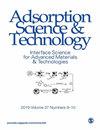Sequestration of Hazardous Dyes from Aqueous Solution Using Raw and Modified Agricultural Waste
IF 2.8
4区 工程技术
Q2 CHEMISTRY, APPLIED
引用次数: 8
Abstract
The continuous degradation of surface water quality by dye materials is of concern globally. Agricultural waste Litchi chinensis (LC) peel in its raw (RL) and modified (CL) forms was used as potential sorbents for sequestration of Congo red (CR) dye from an aqueous solution. The sorbents were characterized before and after sorption with Fourier transform infrared spectroscopy (FTIR), scanning electron microscopy (SEM), energy-dispersive X-ray spectroscopy (EDS), Brunauer, Emmett, and Teller (BET) surface area analysis, and X-ray diffraction (XRD). Determination of the point of zero charge (PZC) suggested CR dye sorption from an aqueous solution would be best in acidic pH. Batch experimental drivers such as the effects of time, dosage, initial concentration, pH, and temperature were optimized and used. Results from the study showed that modification with citric acid (CA) reduced the equilibration time from 90 to 15 min. Change in water chemistry did not significantly affect the removal efficiency of the sorbent but rather slightly improved it for both sorbent types. The smaller particle size of <125 μm recorded higher removal efficiency than the larger one (>125 μm). The effect of temperature affects the sorption differently. For the RL system, it decreases with an increase in the temperature, while for the CL system it increases with an increase in temperature. The Langmuir isotherm best described the equilibrium data obtained based on the linearized coefficients with maximum sorption capacities ( q max ) of 55.56 mg/g (RL) and 58.48 mg/g (CL). The pseudo-second-order model also best described the kinetic data. The thermodynamics study showed that the reaction is both feasible and spontaneous. Both sorbents recorded high removal efficiency for other dyes such as rhodamine B, methylene blue, methyl orange, malachite green, and erythrosin B. The five cycled regeneration/sorption experiments with 0.1 M NaOH as the desorbing agent showed that the regenerated sorbents efficiently removed CR dye from an aqueous solution close to their virgin samples for the first three cycles. This research, therefore, establishes LC peel as a potential eco-friendly, readily available, and effective sorbent for sequestration of hazardous dyes from wastewater.利用原生和改性农业废弃物从水溶液中分离有害染料的研究
染料材料对地表水水质的持续退化引起了全球关注。农业废弃物荔枝皮的生(RL)和改性(CL)形式被用作从水溶液中螯合刚果红(CR)染料的潜在吸附剂。吸附前后用傅立叶变换红外光谱(FTIR)、扫描电子显微镜(SEM)、能量色散X射线光谱(EDS)、Brunauer、Emmett和Teller(BET)表面积分析和X射线衍射(XRD)对吸附剂进行了表征。零电荷点(PZC)的测定表明,CR染料从水溶液中的吸附在酸性pH下最好。优化并使用了分批实验驱动因素,如时间、剂量、初始浓度、pH和温度的影响。研究结果表明,用柠檬酸(CA)改性将平衡时间从90缩短到15 min。水化学性质的变化对吸附剂的去除效率没有显著影响,但对两种吸附剂类型的去除效率略有改善。粒径较小的125 μm)。温度的影响对吸附有不同的影响。对于RL系统,它随着温度的升高而降低,而对于CL系统,它则随着温度的增加而增加。Langmuir等温线最好地描述了基于线性化系数获得的平衡数据,最大吸附容量(q max)为55.56 mg/g(RL)和58.48 mg/g(CL)。伪二阶模型也最好地描述了动力学数据。热力学研究表明,该反应既可行又自发。两种吸附剂对罗丹明B、亚甲基蓝、甲基橙、孔雀石绿和赤藓红素B等其他染料都有很高的去除效率 M NaOH作为解吸剂表明,再生吸附剂在前三个循环中有效地从接近其原始样品的水溶液中去除了CR染料。因此,这项研究将LC果皮确定为一种潜在的环保、易得和有效的吸附剂,用于从废水中分离危险染料。
本文章由计算机程序翻译,如有差异,请以英文原文为准。
求助全文
约1分钟内获得全文
求助全文
来源期刊

Adsorption Science & Technology
工程技术-工程:化工
CiteScore
5.00
自引率
10.30%
发文量
181
审稿时长
4.5 months
期刊介绍:
Adsorption Science & Technology is a peer-reviewed, open access journal devoted to studies of adsorption and desorption phenomena, which publishes original research papers and critical review articles, with occasional special issues relating to particular topics and symposia.
 求助内容:
求助内容: 应助结果提醒方式:
应助结果提醒方式:


